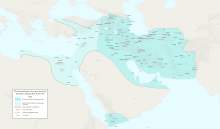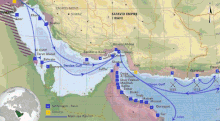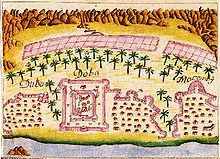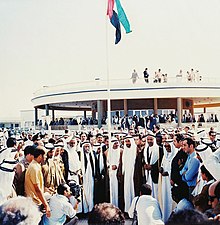History of the United Arab Emirates
[8] As a result of the response of Al Azd tribe to the message of Muhammed, the area became Islamised in the 7th century, a position consolidated by the Ridda Wars and the bloody and definitive Battle of Dibba.Today, the UAE is a modern, oil exporting country with a highly diversified economy, with Dubai in particular developing into a global city and a hub for tourism, retail, and finance,[12] home to the world's tallest building, and largest man-made seaport.In 2011 primitive hand-axes, as well as several kinds of scrapers and perforators, were excavated at the Jebel Faya archaeological site in the United Arab Emirates.The archaeological record shows that Arabian Bifacial/Ubaid period came to an abrupt end in eastern Arabia and the Oman peninsula at 3800 BC, just after the phase of lake lowering and onset of dune reactivation.[17] The re-emergence of human habitation, the Hafit period was named after extensive finds of burials of distinctive beehive shaped tombs in the mountainous area of Jebel Hafeet in Al Ain Region.Hafit period tombs and remains have also been located across the UAE and Oman in sites such as Bidaa bint Saud,[19] Jebel Buhais and Buraimi.One element of the Umm Al Nar culture is circular tombs typically characterized by well fitted stones in the outer wall and multiple human remains within.[23] The Umm Al Nar culture covers some six centuries (2600-2000 BCE), and includes further extensive evidence both of trade with the Sumerian and Akkadian kingdoms as well as with the Indus Valley.Key archaeological sites pointing to major trading cities extant during both periods exist on both the Western and Eastern coasts of the UAE and in Oman, including Dalma, Umm Al Nar, Sufouh, Ed Dur, Tell Abraq and Kalba.The domestication of camels and other animals took place during the Wadi Suq era (2000-1300 BCE),[25] leading to increased inland settlement and the cultivation of diverse crops, including the date palm.Beginning in 300 BC, archaeological evidence shows the remains of a large city, with its capital inside present day Sharjah, in the town of Mleiha.However, monumental tombs built out of stone and mud-brick were erected, suggesting that the occupants were able to build permanent structures, but willingly lived a nomadic lifestyle.Large palace complexes were built for the ruling class, however after the 3rd century AD the entire site appears to be abandoned and this seems to mark the fall of the kingdom.[18] The pearling industry was part of the main economy of the coastal communities across Eastern Arabia and thrived in the relative calm at sea, providing both income and employment to the people of the Persian Gulf.The huge rise in demand by the expanding Indian and European market led to the exploitation of more distant banks such as the areas in Abu Dhabi and Dubai.[33] The Portuguese Empire took over the taxation system which existed in the northern coast and was collected by the Sultan of Hormuz from 1523 to 1622 and continued to gain revenue from it up to the second decade of the 18th century.[31] At the start of the pearling season, which was from June to September, thousands of local ships would gather at a fixed place with necessary provisions to last for up to three months at sea and a day of commencement would be agreed on.[42][43] After an additional year of recurring attacks, at the end of 1818 Hassan bin Rahmah made conciliatory overtures to Bombay and was "sternly rejected."The 1820 treaty was followed by the 1847 'Engagement to Prohibit Exportation of Slaves From Africa on board of Vessels Belonging to Bahrain and to the Trucial States and the Allow Right of Search of April–May 1847'.The Political Resident in the Gulf headed the small team responsible for liaison with the Trucial Sheikhs and was based in Bushire until 1946, when his office was moved to Bahrain.As oil revenues increased, the ruler of Abu Dhabi, Sheikh Zayed bin Sultan Al Nahyan, undertook a massive construction program, building schools, housing, hospitals and roads.The Sulṭan of Muscat and Imam of Oman gathered their forces to expel the Saudis but were persuaded by the British Government to exercise restraint pending attempts to settle the dispute by arbitration.[60] The dispute was finally settled in 1974 by an agreement, known as the Treaty of Jeddah, between Sheikh Zayed (then President of the UAE) and King Faisal of Saudi Arabia.Denis Healey, who, at the time, was the UK Secretary of State for Defence, reported that the British Armed Forces were severely overextended, and in some respects, dangerously under-equipped to defend the Sheikhdoms.On the issue of the shah of Iran's intentions, there are conflicting views: Abdullah Omran Taryam states that Iran was contemplating the occupation of Bahrain and other islands in the Gulf, while Alvandi Roham writes that the shah had no intention of using force to resolve the Bahrain question and was seeking a “package deal” with Great Britain over the Tunb Islands and Abu Musa, which was refused.[70][71] After Labour MP Goronwy Roberts informed Sheikh Zayed of the news of British withdrawal, the nine Persian Gulf sheikhdoms attempted to form a federation of Arab emirates.[71] The federation was first proposed in February 1968 when the rulers of Abu Dhabi and Dubai met in the desert location of Argoub El Sedirah, and agreed on the principle of Union.While Dubai's ruler, Sheikh Rashid, had a strong connection to the Qatari ruling family, including the royal intermarriage of his daughter with the son of the Qatari emir,[74] the relationship between Abu Dhabi and Dubai (also cemented by intermarriage, Rashid's wife was a member of Abu Dhabi's ruling family[72]) was to endure the break-up of the talks with both Bahrain and Qatar.[74] Shortly after the meeting, the Political Agent in Abu Dhabi revealed the British government's interests in the outcome of the session, prompting Qatar to withdraw from the federation apparently over what it perceived as foreign interference in internal affairs.[89] The move to form a union took place at a time of unprecedented instability in the region, with a border dispute that resulted 22 deaths in Kalba, and a coup in Sharjah in January 1972.

























Bronze AgeMagan civilizationUmm Al Nar cultureWadi Suq cultureMleihaAl AshooshAl SufouhEd-DurSaruq Al HadidShimalTell AbraqIron AgeIron Age in the United Arab EmiratesAl ThuqeibahBidaa Bint SaudMuweilahSeih Al HarfQattara OasisRumailahSasanian ruleBattle of DibbaJulfarJumeirah Archaeological SiteWadi SurPersian Gulf campaign of 1809Persian Gulf campaign of 1819General Maritime Treaty of 1820Perpetual Maritime TruceTrucial StatesBuraimi DisputeSaudi Arabia–United Arab Emirates border disputeSeizure of Abu Musa and the Greater and Lesser TunbsFirst parliamentary electionYemeni Civil WarQatar blockadeSocotra disputeCOVID-19 pandemicArchaeologyAncient settlementsUnited Arab Emirateseastern partArabian PeninsulaPersian GulfGulf of OmanemiratesAbu DhabiSharjahUmm Al QuwainFujairahRas al Khaimahtruce treatiesMagan peopleSumeriansHarappanBactriathree defined Iron AgesentrepôtAl AzdMuhammedIslamisedRidda WarsKhor FakkanKingdom of HormuzAl AinPortugueseAfonso de AlbuquerqueSheikh Zayed bin Sultan Al NahyanSheikh Rashid bin Saeed Al Maktoumglobal cityMezyadJebel Hafeet Desert ParkEastern RegionJebel Fayaearly modern humansEast Africathermoluminescence datingUmm Al NarWadi SuqMleiha Archaeological CentreGlacial periodglacial maximum periodarea of Baynunahwestern regionHafit periodAl Ain RegionJemdet NasrJebel BuhaisBuraimiUmm Al Nar siteLouvre Abu DhabiEmirate of SharjahSumerianAkkadianIndus ValleySufouhEd DurMesopotamiaAchaemenidmud-brickPre-IslamicQaryat Al FawPliny the ElderStraboIslam in the United Arab EmiratesTuwwamAl-HajarAl HasamarketsAl-MuqaddasiKhosrow IIMuhammadone of the major battlesLaqit bin Malik Al-AzdiPortuguese EmpireDibba Al-HisnEastern ArabiaArabicZayed bin Khalifa Al NahyanKhasabBandar KongPortuguese Armadacultured pearlGreat Depressionused slave labourPiracy in the Persian GulfZayed the First